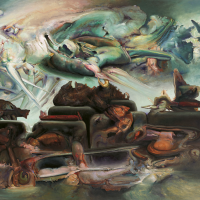42. JAMES GLEESON

James Gleesons magisterial The Wall, of 1986, was originally exhibited in the renowned gallery of his long-term friend Frank Watters. Since then it has remained in a private collection and is offered at auction here for the first time.
Gleeson, (AM 1975; AO 1990; Hon. D. Letters, Macquarie University 1985) was the most important and consistent exponent of Surrealist art in Australia. Gleesons achievements are numerous: he held forty-four solo exhibitions, participated in forty-eight group exhibitions and wrote fifteen major publications in the sixty-two years of his working life between 1938 and 2000. The National Gallery of Victoria held the largest and most extensive retrospective exhibition of his work in 2004 and in the following year the then Governor of New South Wales (Professor The Hon. Dame Marie Bashir AD, CVO) held a birthday party for him at Government House to celebrate his ninetieth year.
Gleesons work was represented at the first Contemporary Art Society exhibition in Sydney in 1938 and is held in the collections of the National Gallery of Australia, all Australian State galleries, most regional galleries and major private collections. In 1993, Professor Di Yerbury, the then Vice Chancellor of Macquarie University, announced the establishment of the James Gleeson Foundation to assist in the purchasing of paintings for the Art Gallery of New South Wales.
The present painting belongs to a significant period in Gleesons artistic life. In 1983, he embarked upon a major series of large paintings that were intended to present a new aesthetic content with a scope and technical facility that heightened their cosmic associations. He had in mind a type of epic tale of caution; one that pictorialised a metamorphosed message that is prophetic and bleak. He believed that we now live in a world overcome by what he always called feral technology a type of industrialisation that had grown wild. In Gleesons always polite opinion, one that never allowed for preaching, technologys seductive gifts are often grotesque and unfortunately lead to mutant side effects. When considered in the contemporary context of environmental disasters, such as pollution and toxic waste spills and the long-term tragedies of the Minamata mercury scandals in Japan, one can appreciate some of the hidden meaning in the coagulated forms of Gleesons paintings of the series.
All the major paintings in the series arise from a horizontally split compositional field of upper and lower pictorial registers. In all of them, the viewers eye moves upward to a delicately painted yet ominous sky that hangs over a darkened foreground of deformed shapes. The resultant visual fold in the pictorial field owes its existence to Gleesons use of the process of decalcomania - a Surrealist procedure of artistic inspiration that was first developed by the Spanish artist Oscar Domnguez (1906-1957) in Paris in 1930. Essentially, the Rorschach-like technique enabled an automatist and self-generating association of images to develop in the mind of the artist, so that he acted like a spectator at the birth of the work as the German artist Max Ernst aptly described it. In decalcomania the viewer is invited to share in the artists vision; to conjure up visual images, as free as those we all enjoyed as children, lying on our backs in the grass, swapping imaginative associations and comparing the suggestive shapes of clouds. Paintings such as these invite viewers to peer and perceive and re-experience the traces of Gleesons visual imagination and share his aesthetic associations.
Thus considered, these large and confronting works, more particularly the current painting, represent interpretations of environmental disasters - the sandbagged detritus of urban dreams, the mutant forms and the deformed growths; all of them billowing affronts to Nature and insults to the vain pride of Humanity.
Gleesons wonderfully accomplished painting, The Wall of 1986, configures the highly respected artists artistically realised dismay at the hidden underside of feral technology and the shortcomings of a world in love with cold rationalism and even colder comforts. Gleesons painterly imagination seems to mock technological conceits; he did not paint apocalyptic parables but flashed up wonderfully rendered warning visions of environmental blindness.
Associate Professor Ken Wach
Dip. Art; T.T.T.C.; Fellowship RMIT; MA; PhD.
Emeritus Principal Research Fellow
and Head of the School of Creative Arts
The University of Melbourne